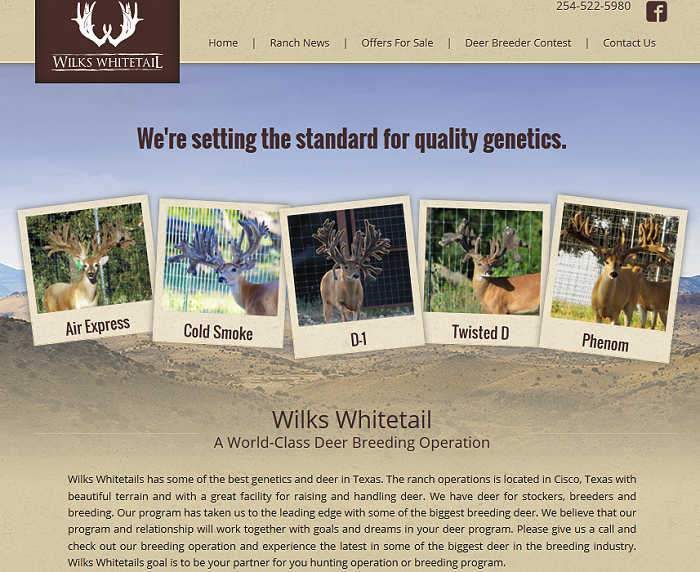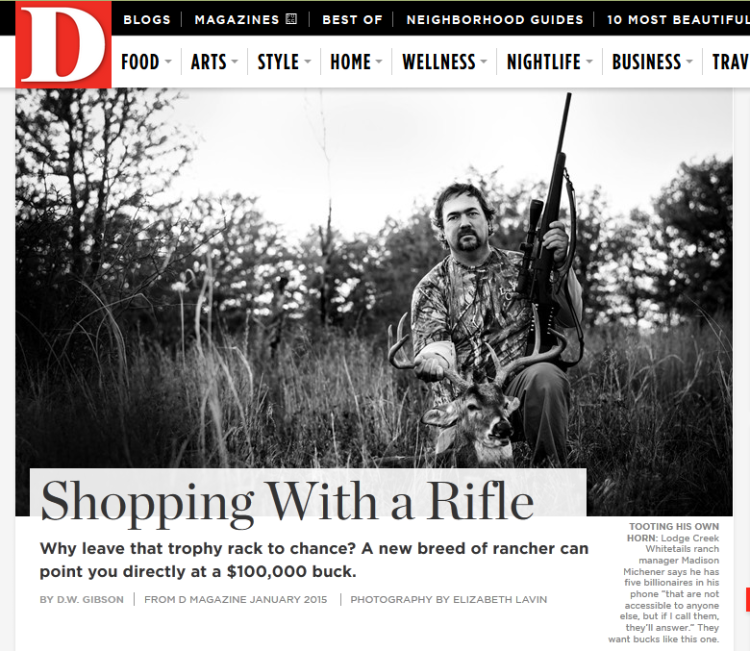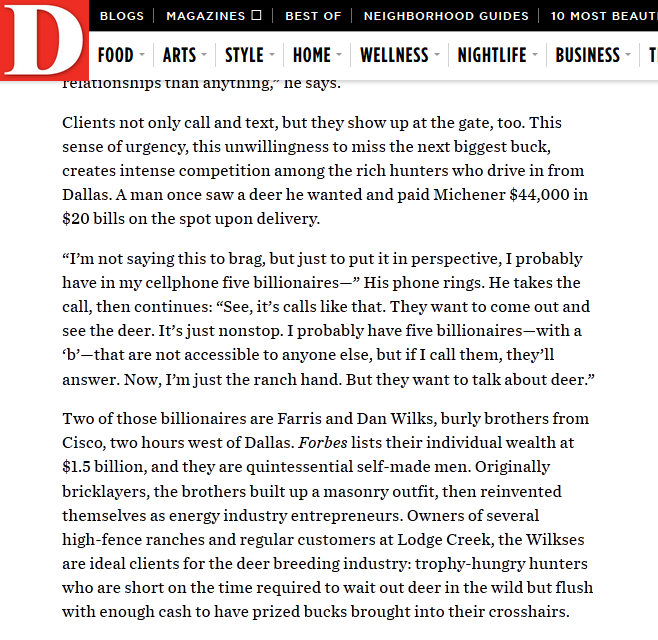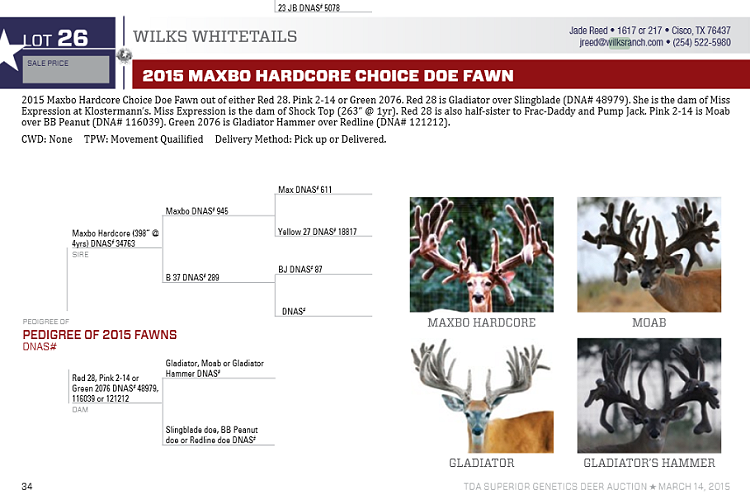Wilks
Brothers Game Ranching
Click
for background information on the Wilks BLM land exchange proposal
that threatens not only our public lands, but one of the largest
elk populations in Montana.
What can Montanans
expect from the Wilks "wildlife management"?
August 28th Billings
Gazette wrote an article, "Wilks brothers offer hunting
access through ranch in north-central Montana". There have
been a plethora of these articles of late.
But this one really
pisses me off, because it is trying NOW, to make it seem the
elk are a problem on the landscape, not mentioning all the Wilks
attempts to privatize that elk population. Concerning the Block
Management carrot it states, "Although the offer can't
be considered by the BLM in its process, the move would help
Montana Fish, Wildlife and Parks cut the growth of an expanding
elk herd that seeks refuge during the hunting season
on the Wilkses' private N Bar Ranch."
Those elk
have always been there, it is elk habitat, the Wilks knew that
when they bought the place. The statewide elk plan
for the Snowy EMU states, "A large proportion of the occupied
elk habitat is comprised of privately owned land, which the
majority of the elk use year-round."
Supreme
Court of Montana. State V. C. R. Rathbone decision, "Montana
is one of the few areas in the nation where wild game abounds.
It is regarded as one of the greatest of the state's natural
resources, as well as the chief attraction for visitors. Wild
game existed here long before the coming of man. One
who acquires property in Montana does so with notice and knowledge
of the presence of wild game and presumably is cognizant of
its natural habits. Wild game does not possess the
power to distinguish between fructus naturales and fructus industriales,
and cannot like domestic animals be controlled through an owner.
Accordingly a property owner in this state must recognize the
fact that there may be some injury to property or inconvenience
from wild game for which there is no recourse." C.R. Rathbone
was convicted for shooting an elk, out of season, for eating
the grass at his ranch.)
That elk herd belongs
to the public, and those elk are not seeking "refuge"
on the NBar, they came with the NBar, even before the original
NBar that was created in 1882, here in Montana - the Niobrara
Cattle Company, "Although N Bar headquarters was established
in 1885, the story of the N Bar actually dates back to 1878
with two brothers. E. S. 'Zeke' and Henry H. J. Newman were
originally from Texas and were some of the first ranchers to
settle in the Nebraska sandhills and to trail cattle from Mexico
and Texas into Montana. "
The
NBar website states,
This rich landscape abundant with wildlife,
makes the N Bar is one of the finest and most
diverse sporting ranches in Montana... Deer
and elk herds populate the upper timbered reaches of
the ranch...The elk herds that roam the N Bar Ranch
are nearly without equal in North America. High-quality
forage, mineral-laden food sources, limited hunting
and outstanding native genetics combine to support a
vast population that includes an impressive
number of "trophy" animals with bulls that
qualify for record-book status. Approximately
1,900 head of elk from three distinct herds have been
counted on the property, thriving in the ranch's dark
stands of north-facing Douglas Fir that give way to
ridges of scattered Ponderosa Pine, stands of aspen
and grassy meadows that descend from the high country
into bottomlands succulent with forage.
|
The Wilks knew exactly
what they were getting when they bought that place - lots of
gorgeous elk. What they may not have known, was that they "werent
in Kansas anymore" and those public elk belong to the people,
not the landowner, like back in Texas.
In a conversation
with PLWA's president, John Gibson, he recounted an article
in the Billings Gazette a couple years ago - Billionaire
Brothers buying Montana ranches, with his follow up Letter
to the Editor, Landowners
do not manage wildlife.
Hold on. This is Montana,
not Texas. We have an agency called the Montana Department
of Fish, Wildlife and Parks that manages wildlife. Sportsmen
fund this agency and we expect certain results. These
include managing wildlife as a public trust resource
while subscribing to the North American Model of Wildlife
Conservation...
Landowners determine who may access
their private land as well as how that land will be
managed. But their management does not include wildlife.
The Montana Supreme Court states that the presence of
public wildlife upon the land implies no claim of ownership
and is a condition of acquisition or something the buyer
should have recognized at the time the land was purchased.
I hope the land buyers
know this.
|
This 2015 legislative session,
HD 29 Rep. Bill Harris, an outfitting landowner representing
the Wilks Brothers district where a fencing dispute on our BLM
public lands involving the Wilks legal fence height, introduced
a HB
557 to change Montana Legal Fencing description, REMOVING
the height max of 48 inches. We also saw SB245, a bill towards
privatizing our elk populations, thankfully vetoed. This bill
saw Darryl
James, the Wilks representative and lobbyist at the legislature
advocating for this bill.
|
The
Democratic Alternative to Privatization
The North American Model of
Wildlife Conservation
|
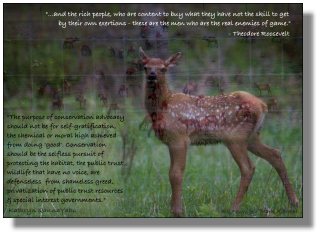
Click to enlarge
|
|
"...
and the rich people, who are content to buy what they
have not the skill to get by their own exertions - these
are the men who are the real enemies of game."
- Theodore Roosevelt
In a 2000
oped
concerning the Montana public's fight against game ranching
- Ballot Initiative 143, written by David Stalling,
L. Jack Lyon, Stan Rauch and Larry Townsend
"These
gentlemen want you to forget that ballot initiatives
happen precisely because people believe their legislative
representatives have failed to protect the public interest
or to perform their duty due to political allegiances
or from a true lack of understanding of an issue. If
the state Legislature... had done a good job for the
people, I-143 would not be necessary...
Renowned
wildlife researcher Valerius Giest calls game ranching
a 'deep but silent crisis' in wildlife conservation,
and says 'the trend toward viewing wildlife as a commodity
has grown, cancerlike, and its severity has not been
sufficiently recognized or appreciated.'
Game farming attacks
the tremendously successful system of North American
wildlife management that was created in the wake of
the market-driven demise of wildlife a 100 years ago.
Today, all hunters depend on this system for their hunting
opportunities.
Game farming is a long
step toward a European system in which wildlife is privately
owned, domesticated and commercialized, bred and manipulated
to meet market demands, and in which hunting is only
for the wealthy and powerful.
But that's
not all. Game farming poses many other serious, well-documented
threats to public wildlife, including disease, hybridization,
genetic pollution, the creation and expansion of commercial
markets for wildlife, loss of wildlife habitat and an
unacceptable, bankrupt image of hunting portrayed by
the paid shooting of captive animals."
The
North American Model of Wildlife Conservation
" The North American Model
of Wildlife Conservation
is a set of principles that, collectively applied,
has led to the form, function, and successes of wildlife
conservation and management in the United States and
Canada."
Chronic Wasting
Disease (CWD)
Additionally, there is
the issue of disease within captive wildlife programs
and ranches. "Texas
is home to 1,300 deer breeders, more than any other
state, but after one confirmed case of chronic wasting
disease last month, officials want to take action now."
The
Wilks fly back and forth between the Durfees (runway
just north of Durfee Hills) and Texas on their private
jet. If you have ever read through academic papers on
Chronic Wasting Disease in wildlife, you would be very
concerned with these prions and how long they can remain
on the landscape.
|
|
So I began looking into the Wilks
Brothers idea of "wildlife management" documented below.
|
|
Wilks Whitetails
is based in Cisco, Texas
The website
states,
"We're setting the
standard for quality genetics.
Wilks Whitetail
A World-Class Deer Breeding Operation
Wilks Whitetails has
some of the best genetics and deer in Texas. The ranch
operations is located in Cisco, Texas with beautiful terrain
and with a great facility for raising and handling deer.
We have deer for stockers, breeders and breeding. Our
program has taken us to the leading edge with some of
the biggest breeding deer. We believe that our program
and relationship will work together with goals and dreams
in your deer program. Please give us a call and check
out our breeding operation and experience the latest in
some of the biggest deer in the breeding industry. Wilks
Whitetails goal is to be your partner for you hunting
operation or breeding program...
Do you need to stock
your hunting ranch with some of the best shooter bucks
we can help provide those to you. These genetics can and
will help hunting ranches for years to come."
Wilks
Whitetails Video showing deer obviously having difficulty
with unnatural racks.
|
| |
D Magazine,
January 2015
Shopping
with a Rifle, interview with Madison Michener of Lodge
Creek Whitetails Ranch concerning Dan and Farris Wilks
trophy rack deer breeding and HR (High Fence) ranches.
"Clients not only
call and text, but they show up at the gate, too. This
sense of urgency, this unwillingness to miss the next
biggest buck, creates intense competition among the rich
hunters who drive in from Dallas. A man once saw a deer
he wanted and paid Michener $44,000 in $20 bills on the
spot upon delivery.
“I’m not
saying this to brag, but just to put it in perspective,
I probably have in my cellphone five billionaires—”
His phone rings. He takes the call, then continues: “See,
it’s calls like that. They want to come out and
see the deer. It’s just nonstop. I probably have
five billionaires—with a ‘b’—that
are not accessible to anyone else, but if I call them,
they’ll answer. Now, I’m just the ranch hand.
But they want to talk about deer.”
Two of those billionaires
are Farris and Dan Wilks, burly brothers from Cisco, two
hours west of Dallas. Forbes lists their individual wealth
at $1.5 billion, and they are quintessential self-made
men. Originally bricklayers, the brothers built up a masonry
outfit, then reinvented themselves as energy industry
entrepreneurs. Owners of several high-fence ranches and
regular customers at Lodge Creek, the Wilkses are ideal
clients for the deer breeding industry: trophy-hungry
hunters who are short on the time required to wait out
deer in the wild but flush with enough cash to have prized
bucks brought into their crosshairs."
|
|
page
under construction
Click
for EMWH.ORG
|


